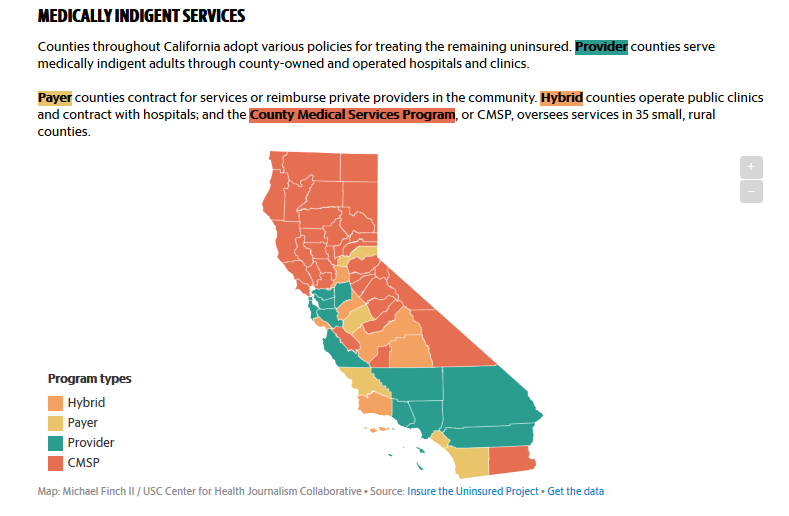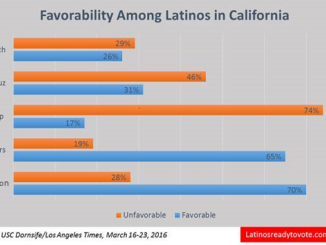
In the outpatient waiting room at Zuckerberg San Francisco General Hospital, Spanish and Chinese chatter spills from pharmacy windows as other patients doze on chairs or play on their phones.
When the overhead speaker beckons, they step forward with stacks of paperwork and walk out with brown paper prescription bags.
The room is bustling with patients using Healthy San Francisco, one of California’s most comprehensive county health programs for people who don’t qualify for state or federal insurance because of their immigration status.
Other counties cover fewer people, offer only basic services, or exclude the undocumented entirely. Where a person lives can make all the difference in whether health care is available at all outside of emergency rooms.
Alice Kurniadi, a program manager with the San Francisco Department of Public Health, says getting people both preventive and follow-up care is key to bringing down costs and helping people live longer.
“Healthy San Francisco is kind of serving as a model,” she said. “It still is a program that’s needed, because we don’t have true universal coverage and there are people who are still left out.”
A new report released Thursday by the Insure the Uninsured Project, a nonprofit group pushing for universal health care, shows that county programs for the medically indigent are generally serving fewer people now than they did before the Affordable Care Act.
At the same time, more counties are offering some level of care to their undocumented population than ever before. Because health providers seldom ask patients about immigration status, there’s no way to calculate how many undocumented people are served through county-run clinics and hospitals.
But advocates say it’s a small fraction of the state’s 1.5 million undocumented and uninsured people in California, many of whom seek treatment only in emergency situations. Under state law, hospitals must treat all emergency patients. Most counties provide primary care, but getting care for chronic conditions that require specialists can be difficult.
Counties with the leanest benefits leave people with untreated diabetes, hypertension or cancer — conditions that can lead to much more severe illness or even preventable death, according to Laurel Lucia, director of the Health Care Program at the UC Berkeley Labor Center.
Undocumented children are currently covered by Medi-Cal and the full cost of their non-emergency care is paid by the state. But when it comes to undocumented adults, some counties are reluctant to cover non-emergency care because they would have to foot the entire bill. Others simply feel it isn’t their responsibility.
Anthony Wright, president of the consumer group Health Access, says counties vary “widely and wildly” in what they offer this population. “The county is a last-resort safety net that is there in some areas and less so in others,” he said. “People have different access to health care based on the county they’re in. And at the end of the day that’s not a great policy.”
A changing map
Before the Affordable Care Act took effect in 2014, county health departments treated all sorts of people without insurance, including single adults, homeless individuals and people who made too much money to qualify for state programs.
At that time, the state had more than 3 million uninsured. But when California broadened Medi-Cal eligibility and created the Covered California health exchange, many of those people gained insurance coverage and stopped relying on their counties for free or subsidized care.
The state also shifted the amount of funding going to counties to cover the medically indigent. That opened a door for counties to either run smaller programs or start covering people they’d previously excluded. The number of county programs serving medically indigent adults regardless of immigration status jumped from 11 to 47 between October 2017 and July 2018, according to the report from the Insure the Uninsured Project.
Still, standards of care vary. Some counties provide people with a card, but it’s not the same as having health insurance. It’s just a way to show eligibility for subsidized care in a county clinic, a public hospital, or a provider the county is contracting with.
“When we say they’re ‘covering the undocumented,’ what do we really mean by that?” said Deborah Kelch, executive director of the Insure the Uninsured Project. “That’s a piece we all need to put into the mix.”
For instance, Sacramento County’s Healthy Partners program launched in 2016 to offer services to the uninsured, regardless of immigration status. It was open to adults who are already enrolled in restricted scope Medi-Cal, younger than 64 and below a certain income bracket — roughly $16,548 a year for an individual or $34,638 a year for a family of four.
The program originally had a 3,000-patient cap, though there are an estimated 65,000 undocumented adults in the county. Immigrant advocacy groups successfully fought to raise the cap to 4,000 patients and remove the upper age limit in 2018, but it still falls far short of the requests for medical care.
Holandesa Lopez left Nicaragua 17 years ago. She sought a better life in California, but found herself longing for the family and career she had left back home. Though the shock of her new life often sent her into bouts of depression, her immigration status kept her from seeking help. Five years ago, she developed a problem she couldn’t ignore — an abdominal pain so intense she would lie on the floor until it went away.
When it became unbearable, she went to the hospital for help in hopes of using her emergency Medi-Cal to receive care. An exam and MRI showed she had a mass in her pancreas, but the hospital wouldn’t take it out.
“My digestive system was getting worse, and I could tell,” she said through a translator. “I couldn’t work. I couldn’t take care of my son. I began to knock on people’s doors everywhere … Everybody told me the same thing, that I needed to have money in order to get my operation.”
Back at the hospital a year later, doctors told Lopez the benign mass had doubled in size, but they couldn’t operate because it wasn’t an emergency. She eventually got pro bono surgery at another hospital through a charity program.
Now, she gets her care — including therapy — at WellSpace Health, a network of community clinics. But she worries that won’t suffice if she ever needs surgery again.
Sacramento County’s Healthy Partners program covers specialty services and inpatient hospital care, but Lopez said she’d never heard of it. If either of two bills moving through the legislature become law, Medi-Cal could expand to all income-qualifying adults
Lopez said she would sign up without a second thought.
“Coming to this country, the only thing they care about is the child,” she said. “They don’t treat the mother. They only treat the child because he’s the one who has a Social Security number. But they never take into consideration the mother, her health problems, her mental health problems.”
Some counties have been adamant that treating the undocumented is not their responsibility.
Fresno County won a 2014 lawsuit concluding that it didn’t have to cover the undocumented population.
David Pomaville, director of public health administration for the county, said they simply couldn’t pay for it.
“We would have had to make really draconian cuts to the rest of public health in favor of the undocumented program the way it existed,” he said.
The county eventually created a new referral system, which directs patients to community clinics. It currently serves about 400 people.
Pomaville said it isn’t a sustainable solution.
“Leaving counties to solve this problem, I think is unrealistic,” he said. “This is a band-aid on a bigger problem that needs to be addressed statewide.”
This article is part of the USC Center for Health Journalism News Collaborative, which involves print and broadcast journalists across California. The Bee’s Michael Finch II, the Orange County Register’s Deepa Bharath, The (Palm Spring) Desert Sun’s Nicole Hayden and Univision 21 Fresno’s Jose Gonzalez contributed to this report.




